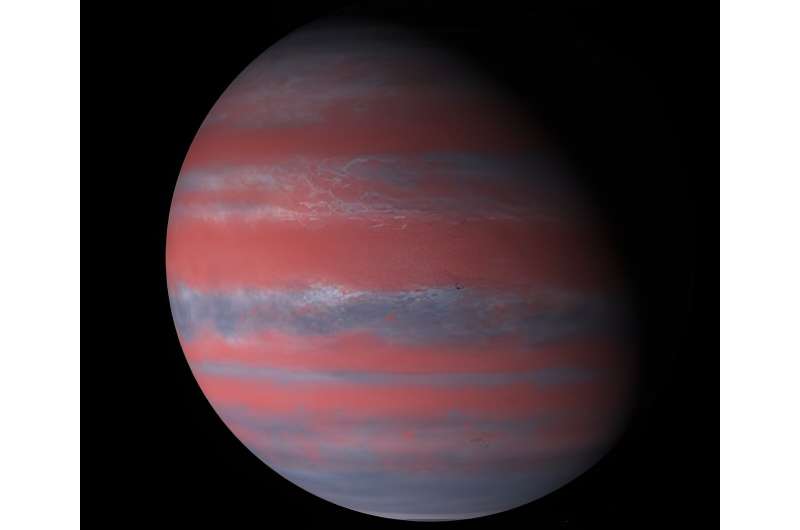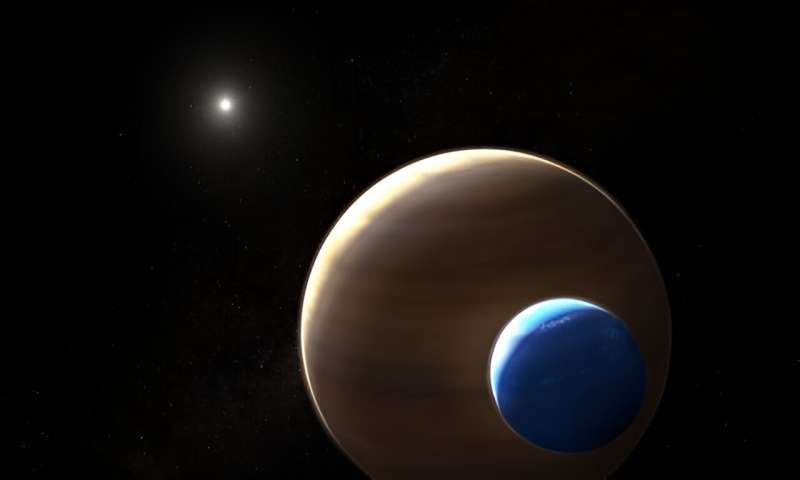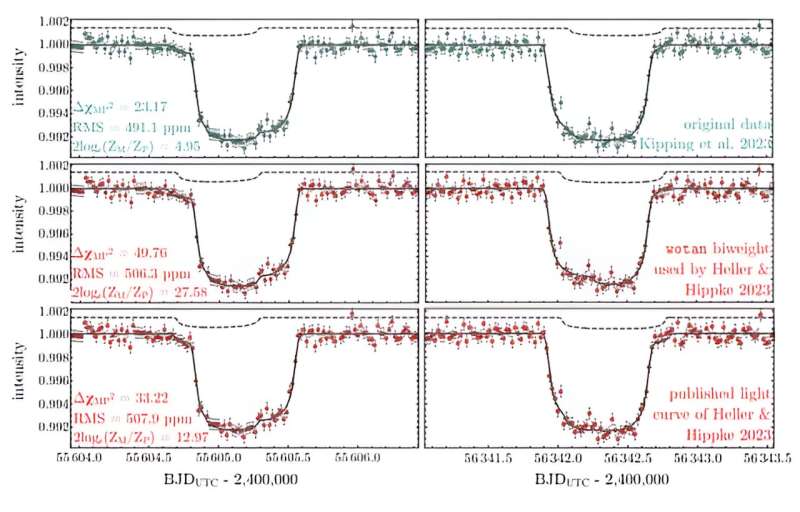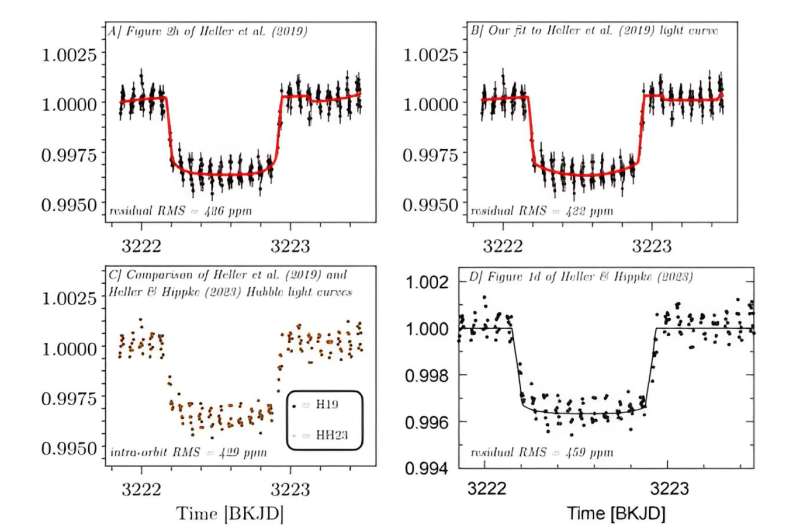This article has been reviewed according to Science X's editorial process and policies. Editors have highlighted the following attributes while ensuring the content's credibility:
fact-checked
peer-reviewed publication
trusted source
proofread
Did we find exomoons or not?

Do exoplanets have exomoons? It would be extraordinary if they didn't, but as with all things, we don't know until we know. Astronomers thought they may have found exomoons several years ago around two exoplanets: Kepler-1625b and Kepler-1708b. Did they?
In 2017, researchers found evidence of moons around Kepler-1625b and Kepler-1708b. It was an exciting result, though the researchers warned their findings were inconclusive. They hoped that the Hubble would be able to confirm the exomoons. "Finally, we report evidence for an exomoon candidate Kepler-1625b I, which we briefly describe ahead of scheduled observations of the target with the Hubble Space Telescope," wrote the authors (Teachey et al).
More recently, Rene Heller and Michael Hippke wrote in Nature Astronomy that the data Teachey et al relied on does not support exomoons. "The probability of a moon orbiting Kepler-1708b is clearly lower than previously reported," said research co-author Michael Hippke from the Sonneberg Observatory. "The data do not suggest the existence of an exomoon around Kepler-1708b," he added. Heller and Hippke said the same thing about Kepler-1625b.
Now, a group of researchers, including two of the authors of the original 2017 research that showed evidence of the exomoons, David Kipping and Alex Teachey, have responded to Heller and Hippke.
"Recently, Heller & Hippke argued that the exomoon candidates Kepler-1625 b-i and Kepler-1708 b-i were allegedly 'refuted,'" Kipping and Teachey write. They claim that Heller and Hippke discarded too much useful data, eliminating the exomoon-supporting signal in the Hubble light curves for Kepler-1625 b-i. Their response is in a Matters Arising article under consideration by Nature Astronomy and currently available on the arXiv preprint server.
Detecting exomoons is extremely difficult. The only evidence is in light curves. The two exoplanets at issue, Kepler-1625 b and Kepler-1708b are 8,200 and 5,500 light-years away, respectively. Even though we often talk about galaxies that are several billions of light years away, these two planets are at an extreme distance. It's easy to forget that and how difficult they are to observe.

Kepler found the pair of exoplanets in this work with the transit method. The transit method measures the dip in light caused by a planet passing in front of its star. The transit produces a light curve, which astronomers analyze for the presence of a planet. An exomoon around a planet detected with the transit method produces its own dip in light, a sub-transit if you will.
But these light curves don't jump out of the data. It takes detailed analysis to find them. Exomoon light curves are much fainter than exoplanet light curves. Since they're so faint, noise in the signal can obscure them or even present false signals. Only structured analysis can reveal these faint exomoon light curves, and there are more ways than one to analyze this type of data. Different researchers employ different methods, models, and algorithms to analyze data, and sometimes they even exclude data that other researchers retain. It's not simple.
In this case, Kipping and Teachey say that Heller and Hippke made errors in their analysis and also excluded critical information.
"We demonstrate that their Hubble light curve exhibits ~20% higher noise and discards 11% of the useful data, which compromises its ability to recover the subtle signal of Kepler-1625 b-i," write Kipping and Teachey.
Something similar occurred with Kepler-1708 b-i, too. Kipping and Teacher write that Heller and Hippke mishandled some of the data, particularly the choices they made when detrending it. Detrending refers to removing a trend in data to allow cyclical and other patterns to emerge. Heller and Hippke's analysis and detrending indicated no exomoon around Kepler-1708 b-i. But when Kipping and Teacher analyzed Heller and Hippke's work, they said they could "… recover the original moon signal, to even higher confidence than before."
Kipping and Teacher are very clear about one thing: "We begin by first clearly stating: both exomoon candidates may not be real. Our original and continued claim is modest: these objects are candidates for which the data exhibits substantial but not entirely conclusive evidence in favor of exomoons."
Kepler-1708b
Kipping and Teacher say that Heller and Hippke's analysis is flawed. For Kepler-1708 b-i, the light curve still shows a potential exomoon, shown in all of the panels below as a dashed line.

In their 2023 paper contradicting the exomoon explanation, Heller and Hippke wrote that "The proposed exomoon transit signal is not distinct from other sources of variations in the light curve, which are probably of stellar or systematic origin. "However, Kipping and Teacher's work shows that the curve is still there in the data.
Kepler-1625 b-i
Kipping and Teacher also take exception to Heller and Hippke's analysis of Kepler-1625 b-i. K & T again say that the other researchers made errors in their analysis. For one thing, Heller and Hippke removed the first exposure in each orbit. This means that there's 11% less valuable data. K & T explain that removing this much data works against detecting such a faint exomoon signal.
K & T also point out that Heller and Hippke did not provide important data when requested, even by e-mail correspondence. That could be a red flag, or it could have a simple explanation. However, failing to share important data with other researchers is not a good look. "The authors also provide no description of their reduction of the Hubble data, a troubling omission given the notoriously large number of choices required to interpret an instrument with such strong systematics," K & T write.

K & T assumed, for the purposes of this work, that Heller and Hippke used the data reduction that they used in previously published work. The results? K & T still found signals indicating a possible exomoon.
"Heller & Hippke concluded that the exomoon candidates Kepler-1625 b-i and Kepler-1708 b-i are unlikely, but we have shown that their arguments are fundamentally flawed, stemming from numerous choices and interpretations that do not hold up to scrutiny," Kipping and Teacher write.
Barring any further response from Heller and Hippke, the last words go to Kipping and Teacher. "We conclude that both candidates remain viable but certainly demand further observations."
More information: David Kipping et al, A Reply to: Large Exomoons unlikely around Kepler-1625 b and Kepler-1708 b, arXiv (2024). DOI: 10.48550/arxiv.2401.10333
Journal information: Nature Astronomy , arXiv
Provided by Universe Today





















